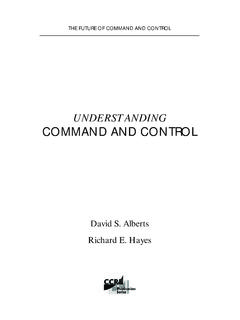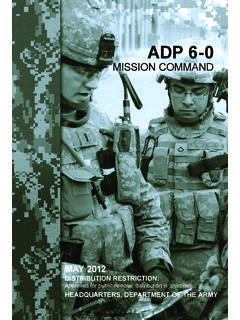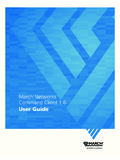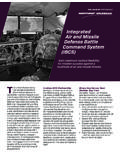Transcription of DTIC
1 AD-A240 17811111 I I II l ILt Ill 1 I11 Ilil' ' " iSpan of control and The Operational Commander:Is It More Than Just a Number?A MonographbyMajor William G. PierceCorps of EngineersDTIC"I " WCTESEP 12 191n'SDSchool of Advanced Military StudiesUnited States Army command and General Staff CollegeFort Leavenworth, KansasSecond Term 90-91 Approved for Public Release; Distrlbutlon Is Unlimited91-10369 PoeM Appro=v.'REPORT DOCUMENTATION PAGE OmfI No, 0704-oSP* 11 r thi f gi U l COiW"UOn Of 0fOf111r t11" is flt ited to IWe f Dotr f oot , 0indJund the time for M vwt4 n9 IMOUVh ntSO. MercM"ng 611111g d,4 ate loUra 7. ,41 d mag tt hhe date needed. oft Comprleti ng ev and g w ' t on aI nforma t ion, m Wte. omNWM IS r"0et .a g thl budes ftlUmate or any aOtt ahe l of totto~leaton. Of infoomato4, nlIuding tutilont ot fetlucng 0 Ifofarlaot, to w1 nsuiqtoe if4letmadqta Wiitet, QIPciorate fr Information Operationm and A1 eoort.
2 I1t JeffenonODIV miglowai, wI4te 1304. AOIon4tN, VA ) 3220*.diOZ, thd eitt Orfite of ma h nemvt and Awd1 Lat PFqatvwo Rdu Pcilon Prop"e (070440 110), Watbrinqtaf, OC Io0I .1, AGENCY USE ONLY (LeavOe blnk) 2. REPORT DATE 3. REPORT TYPE AND DATES COVERED7 01/05/91 MONOGRAPH4. TITLE AND SUITITLE S. FUNDING NUMBERSSPAN OF control AND THE OPERATIONAL COMMANDER:IS IT MORE THAN JUST A NUMBER?.AUTHOR(S)MAJOR WILLIAM 6. PIERCE, USA7. PERFORMING ORGANIZATION NAME(S) AND ADDRESS(ES) B. PERFORMING ORGANIZATIONREPORT NUMBERSCHOOL OF ADVANCED MILITARY STUDIESATTN i ATZL-SWVFORT LEAVENWORTHI KANSAS 66027-6900I. SPONSIORING4 MONITORINGAGENCY NAME(S) AND ADDRESS(IS) 10. SPONSORING/ MONtITORINGAGENCY REPORT NUMBER1I. SUPPILEMENTARY NOTES124. DISTRIBUTION I AVAILABILITY STATEMENT 12b. DISTRIBUTION CODEAPPROVED FOR PUBLIC RELEASE; DISTRIBUTION UNLIMITED13.
3 ABSTRACT ' .. 200 wo..s)This monograph addresses a fundamental problem inoperational level cbmmand. The operational commander is required by Army andJoint publications to organize his forces. In order to do this, the commandermust understand the limits of his span of control when making his organizationaldecisions. The term span of control is neither defined nor explained in the armyand joint publications. At the tactical level, the span of control isestablished in the applicable TO&Es. At the operational level, this is not thecase. The variables that affect civilian span of control were examined in amilitary context. These factors are personality and organizational driven. Thefactors that have the greatest affect on span of control are similarity offunction of subordinates, style of control the commander uses, the type ofcoordination required between subordinates, and the number of personal contactsthe commander uses to control his forces.
4 In addition, changes in structure,tasks and personnel will affect span of control over time."M4. SUBJECT TERMS 15. NUMBER OF PAGESSPAN OF control , SPAN OF MANAGEMENT, 52 command AND control , DECENTRALIZED command , MILITARY, 1. PRICE"CODEPPFRAT !PNAL I ONAL DRGANI ZAT IONS17. SECURITY CLASSIFICATION 1B. SECURITY CLASSIFICATION 19. SECURITY CLASSIFICATION OF ABSTRACTOF REPORT .OF THIS PAGE OF ABSTRACTI Iwlri Ac- Tr T r]. I iNi AisS T F T Fn UNCLAS IFI TrI UNLIMITEDNSN 7540"1-2605500 Standard Form 298 (Rev. ) " ANU Sld. OF ADVANCED MILITARY STUDIESMONOGRAPH APPROVALName of Student: William G. Pierce. MAJ. Corps of E!na= of Mctnograph: Soan of control and the DoeratlonalCommander: In It More Than Just ANumber?Approved by:M onograph DirectorLTC Ernest R. Rogers, MBAL V x 2 Director, School ofC James R. McDonough,,H5 Atdvanediitr_____Director, GraduatePhilip J.
5 Brookes, Degree ProgramAcceslon For _NTIS CRA&I -D1IC TABU,,dniouocedJ obstitication ..Accepted this -day of 1991 By ..Ditt Ibutlon IAvailablility CodesAvail .. pc IABSTRACTSPAN Of control AND THE OPERATIONAL COMMANDER: IS IT MORE THAN JUST ANUMBER? by Major William 0. Pierce, USA, 52 study examines the issue of span of control for anoperational commander. The operational commander Is required by Jointand Army doctrine to organize his forces. In order to do so, he mustunderstand the limits of his span of control when makingorganizational of control Is not defined In either Army or Jointpublications, but the term Is used In doctrinal manuals. At thetactical level, a span of control between two and five units Isbelieved to be appropriate. However, the commander's span of controlat tactical levels Is much larger when CS, CSS and staff areconsidered.
6 At the operational level, understanding what affects spanof- control Is essential. For subunifled commands, Joint task forceorganizations, field armies or army groups, the operational commandermust establish his own organization, Nowhere In doctrine Is amethodology for doing this the military does not define span of control , there Is awealth of Information on It In management books. This treatment wasexamined In a military context. The factors that have the mostInfluence on the coumander's span of control are the similarity offunction of the subordinates, the style of control of the commander,the type of coordination between the commander and his subordinates,and the number of personal contacts that the commander uses In hiscommand style. Changes In the structure, tasks, and personnel willalso affect the limits of span of control over time.
7 Unfortunately,understanding the factors that Influence span of control will not helpa commander establish his Inltial span of control . They will onlyhelp him adJust his span of control given a number of subordinates anda situation. Thus, two to five subordinates appear to be a goodstarting place when the commander organizes his forces. Then, thecommander must adjust his span of control based on the are three major doctrinal implications in this study. TheArmy and Joint doctrine provides no Information on how to organizeforces -only that It must be done. This doctrinal void must befilled In future publications. The second Is the criticality ofreducing the amount of Information the commander Is presented duringbattle. The commander must establish a Commander's CriticalInformation Requirements (CCIR) and this list should be added to allcampaign plans.
8 This will ensure that all subordinate elements focuson what the commander needs to make his decisions. This will help thecomnander expand his rpan of control . Finally, the military educatlunsystem must Inculcate In all officers the philosophy and traits thatfoster decentralized control . This Is the primary factor that willenable a commander to expand his span of of ContentsSI. Introduction ..Il. Span of control Doctrine .. 4 III. Span of control Theory -A Civilian 14IV. Military Limits of Span of control ..20V. Conclusion ..38 Endnotes ..41 Bibliography ..48 INTRODUCTIONC ommand and control (C2) has been subjected to a considerableamount of scrutiny in the recent past. Lieutenant General Leonard , Combined Arms Center Commanding General, addressed C2 In anarticle In Military Review where he referred to Operation Just synchronized combat assault simultaneously placed Jointforces at dozens of different locations, totally fixed theenemy and kept casualties and collateral damage to a training prepared the units Involved, while superbleadership at all echelons, decentralized command and controland superior C2 systems allowed the swift and decis veexecution of this highly successful contingency Just Cause was a success, partly becaive of excellentC2.
9 What exactly is command and control ? Joint Publication 1-02defines command and control as follows:The exercise of authority and direction by a properlydesignated commander over assigned forces In theaccomplishment of the mission. command and control functionsare perfurmed through an arrangement of personnel, equipment,communications, facilities, and procedures which are employedby a commander In planning, directing, coordinating, andcontrolling forces and operations in the accomplishment ofthe Manual 100-5, Operations, does not give a definition ofcommand and control , but Indicates Its importance. The key to thesection on C2 Is, "Common to all operations -- close, deep and rear-- Is the necessity for superior command and control .'8 Thisquotation Implies that effective C2 Is crucial to winning on theAlrLand battlefield. In establishing an effective C2 structure, theoperational commander Is faced with a problem.
10 As the size of theunit Increases, the structure of that unit becomes less defined. Atthe squad level, there Is a well defined structure as outlined in theapplicable Table of Organization and Equipment (TO&W). This holds:: i i i i ii II I II'1true up through the division level. However, at corps and higher(operational) level units, there is no set structure, and these unitsare constructed and organized with specific forces to accomplish theirmission. It will be shown that it Is the operational levelcommander's responsibility to build and organize his forces. Inestablishing these organizations, one of the factors tnat theoperational commander must consider Is the concept of span of does no good to organize a force if there are too many subordinateSheadquarters to control effectively. At the same time, it Is wastefulif the commander Is idle or over-supervises his forces because he hastoo few forces to control .


















